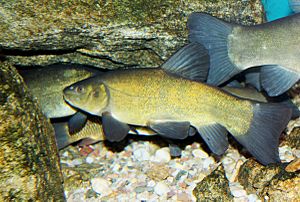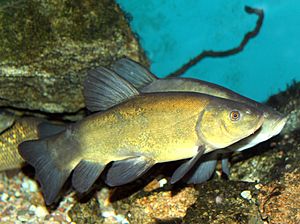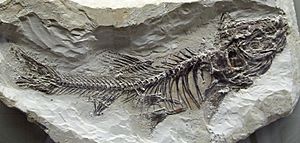Tench facts for kids
Quick facts for kids Tench |
|
|---|---|
 |
|
| Conservation status | |
| Scientific classification | |
| Genus: |
Tinca
|
| Species: |
tinca
|
| Synonyms | |
|
|
The tench (Tinca tinca) is a type of fish found in fresh and slightly salty water. It is also known as the doctor fish. You can find tench all over Europe and Asia, from the British Isles to the Ob and Yenisei Rivers. They also live in Lake Baikal. Tench usually prefer calm waters like lakes and slow-moving rivers.
Contents
About the Tench
The tench was once grouped with other minnows. But newer studies show it belongs to its own special family, called Tincidae.
Tench Habitat and Diet
Tench love still waters that have a muddy or clay bottom. They also like places with lots of plants. You won't often find them in clear water with stony bottoms. They are never in fast-moving streams. Tench can even live in water with very little oxygen. They can survive where other fish, like carp, cannot.
Tench mostly eat at night. They prefer small animals found at the bottom of the water. This includes tiny insect larvae called chironomids. In areas with many plants, they eat snails and small clams.
Tench Reproduction
Tench lay their eggs in shallow water, often among water plants. The eggs are sticky and green. They usually lay eggs in the summer. A single female can lay as many as 300,000 eggs! Young tench grow quickly. They can weigh about 0.11 kg (0.25 lb) in their first year.
What a Tench Looks Like
Tench have a strong, carp-like body shape. Their skin is olive-green, darker on top and almost golden underneath. Their tail fin is square. All their other fins are nicely rounded. The mouth is quite small. It has a tiny whisker-like barbel at each corner.
Tench can grow up to 70 cm (27 inches) long. However, most are much smaller. The biggest tench ever caught in England weighed 6.89 kg (15 lb 3 oz) in 2001. Their eyes are small and have a red-orange color. It's hard to tell male and female tench apart. Females might have a more rounded belly.
Male tench might also have a thicker, flatter outer ray on their lower fins. Males are usually smaller than females. You can sometimes spot males by their more curved lower fins. They also have noticeable muscles near the base of these fins. Females usually don't have these muscles.
Tench have very tiny scales. These scales are deep in their thick skin. This makes them feel as slippery as an eel. Old stories say that the slime on a tench could heal sick fish. This is how they got the name doctor fish.
Golden Tench
There's a special type of tench called the golden tench. People bred this variety on purpose. It's a popular fish for ponds because it looks nice. Golden tench can be pale gold to dark red. Some even have black or red spots on their sides and fins. They look a bit like goldfish. But because their scales are so small, they have a different texture.
Tench and People
Tench are edible fish. They work well in recipes where you might use carp. However, people don't eat them very often these days. They are schooling fish, meaning they swim in groups. This makes them popular for coarse angling (fishing for non-game fish) in rivers, lakes, and canals. Golden tench are also kept as pets in ponds. They are bottom feeders, which helps keep the water clean and healthy.
Fishing for Tench
You can find large tench in gravel pits. They also live in deep, slow-moving waters. These places usually have a clay or silty bottom and lots of water plants. The best ways to catch tench are float fishing or ledgering. This involves using a swim feeder. Good baits include maggots, sweetcorn, pellets, bread, and worms. Tench over 1 kg (2 lb) are very strong fighters when caught on a fishing rod!
See also
 In Spanish: Tinca tinca para niños
In Spanish: Tinca tinca para niños




